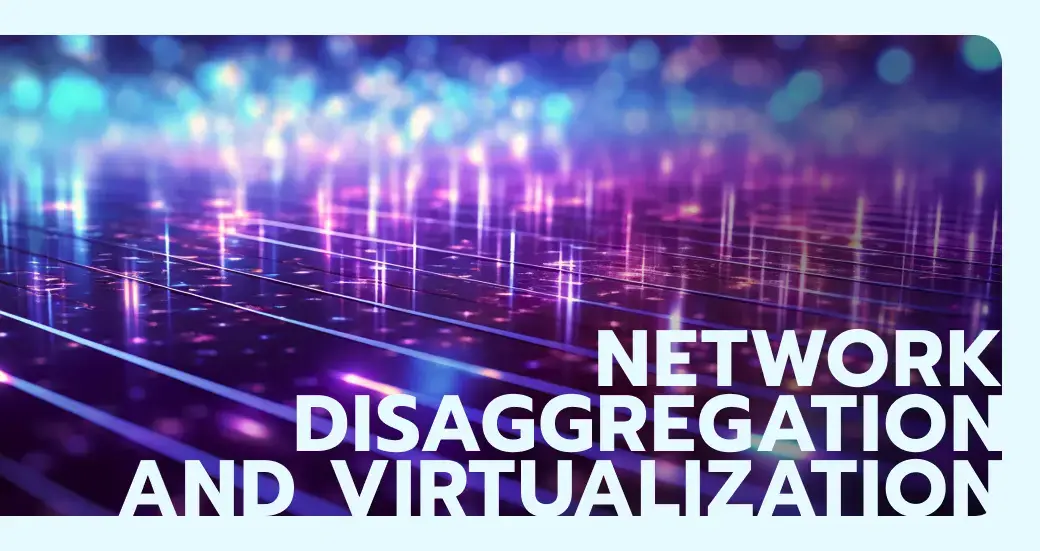AI’s omnipresence in today’s and future telecom industry explained
Learn how AI is transforming the telecom industry and dive into its power to enhance customer experience in 2025 and beyond.

Statista reports that the telecom industry has experienced tremendous growth in 2024. By the end of the year, nearly 1.6 trillion U.S. dollars will have been spent worldwide, representing a 4.3% increase compared to the previous year. Such growth predisposes a continued upward trend, driven by the latest trends like increased investments in the global 5G value chain, network expansion, and innovative digital services that provide a better customer experience. Long story short, the telecommunications industry doesn’t rest on its laurels.
These advancements—and many others—will continue to reshape communication as we know it. Want to stay ahead? Read on to discover the trends set to define telecom in 2025. In this fast-paced industry, standing still is like trying to catch a signal in a dead zone: if you’re not moving forward, you’re out of range.
Figure 1. IT spending in the telecom sector worldwide from 2008 to 2024 (in billion US dollars)

Let’s discuss the most critical trends in the telecommunications industry. While 5G is largely deployed, engineers agree that further advancements are possible to maximize its potential. Though several major telecom companies claim near-complete 5G coverage, the technology still faces challenges related to optimized applications and consistent performance. The next stage of 5G evolution will focus on refining infrastructure and unlocking new business opportunities.
How will this be achieved? Primarily through advanced use cases like Massive Machine-Type Communication (mMTC) and Ultra-Reliable Low Latency Communication (URLLC).
URLLC provides dependable, low-latency connectivity, making it ideal for mission-critical applications such as autonomous vehicles and remote surgery. These connections may not demand high bandwidth but require unmatched stability and ultra-low delay.
On the other hand, mMTC supports up to a million devices per square mile, ideal for large-scale IoT deployments. This capability is crucial for industries like smart cities, logistics, and manufacturing, where thousands of sensors and devices constantly collect and share data.
That was just the first wave of 5G for mass consumers. Now, with the carriers upping their plans for more advanced use cases, 5G is evolving from a faster network into the backbone of the future telecom landscape. 
While the telecom industry is expanding outside traditional network environments, new approaches to network architecture and management are being shaped by Software–Defined Networking (SDN) and Network Function Virtualization. Unlike conventional methods reliant on proprietary hardware, NFV decouples network functions—such as firewalls and load balancers—from physical devices, allowing them to operate as software on standard servers. This shift brings greater flexibility, cost savings, and scalability.
In contrast, SDN enables operators to manage network traffic centrally by utilizing software that dynamically reroutes and manages data flows. That is essentially the roadmap to agile, programmable networks that would respond quickly to dynamic demands.
The adoption of these virtualization technologies turned rigid infrastructures into flexible and scalable systems. This way, it opens up a pathway for faster service delivery, easier maintenance, and the opportunity to introduce newer offerings at a fraction of the cost. The future of the telecom industry in 2025 and beyond lies in software-driven networks that seamlessly adapt to evolving market needs, with NFV and SDN at the core.
This may be one of the biggest telecom industry trends of 2025. After years of resistance, Apple’s decision to adopt Rich Communication Services (RCS) is set to reshape the sector. RCS has long supported Android devices, offering rich media, read receipts, and improved group chat functionality not possible in traditional SMS. However, Apple’s reluctance to adopt the standard has left cross-platform messaging fragmented and inconsistent.
With Apple’s adoption, RCS is set to become a universal messaging protocol, bridging the gap between iOS and Android users. This unified approach will eliminate compatibility issues, allowing seamless communication across platforms. The shift is expected to drive telecom providers to fully upgrade their networks, ensuring comprehensive support for this technology.
This moves RCS to actually be the successor of SMS, providing a consistent and improved messaging experience on all devices for both end-users and enterprises seeking enhanced communication features.
Artificial Intelligence was one of the fastest-adopted technologies in the telecom industry. It’s fascinating to see how it has transitioned from a buzzword to a critical tool that helped transform network management and service delivery. In 2025, AI and ML will continue to be vital in transformation via automation and optimization of complex processes in real-time.
Accelerate AI adoption by choosing the right
cloud platform for it from the onset.
Avenga AI Cloud Companion renders AI adoption 3x faster!

AI has become indispensable for managing telecom networks by automating operations and significantly boosting overall performance.The worldwide AI market for telecommunications is projected to grow at a compound annual growth rate of 41.40% over the next ten years. It is expected to increase from $1.34 billion in 2023 to an astounding $42.66 billion by 2033. Predictive maintenance allows AI models to train on network data for possible pitfalls that can be identified ahead of time and thus, cut downtimes while lowering maintenance costs. Meanwhile, AI-driven network optimization will dynamically change traffic routing and resource allocation to avoid congestion and maintain seamless connectivity.
Beyond infrastructure, AI in telecom is changing the face of customer service. All routine inquiries today are handled by chatbots and virtual assistants. The result is beyond awesome. It enables telecom operators to have a quicker resolution, freeing up human agents to handle more complex issues.
The demand for connectivity is increasing daily. By implementing network diversity techniques that incorporate various technologies, such as fiber, 5G, and satellite, telecom companies are surpassing conventional methods.. Redundancy involves duplicating the same type of connection. Network diversity, on the other hand, relies on using several mediums to establish many independent paths. This creates a more robust and resilient telecommunications infrastructure capable of maintaining performance even during disruptions.
Examples include fiber for high-capacity backbone connections, 5G for low-latency mobile coverage, and satellites in remote areas. These technologies provide improved reliability and flexibility. They support shifting traffic and dynamic resource allocation based on real-time situations. Employing different paths helps telecom companies minimize risks associated with single points of failure, including cable cuts or natural disasters leading to service disruptions.
Network diversity paves the way for intelligent Software-Defined Wide Area Networks (SD-WANs), which manage traffic between these links to further optimize performance and reduce costs. Embracing network diversity will be crucial in meeting the ever-growing global connectivity demands and ensuring seamless service delivery in 2025 and beyond.
The leading telecom service providers are proactively adopting this trend. Virtual trade shows and events have grown to be important sales channels in the telecom industry. They provide telecom service providers with new ways of addressing audiences worldwide. In addition to showcasing products and services, these events allow for personalized sales consultations, enabling one-on-one virtual meetings for deeper explorations of customer requirements. Virtual training sessions are also used to educate resellers, enhancing their capabilities as partners. Moreover, these events are particularly beneficial for new market entrants.”
The meetups also power cross-sell, upsell opportunities, and data-driven insights. All measures are focused on refining sales strategies. This tech trend helps providers to reach more people and increase engagement.
5G drives the expansion toward edge computing, reshaping how data is processed and conveyed. Due to the ultra-low latency and high velocity provided by 5G, edge computing can enable real-time data processing closer to its source, whether from a smart device, an autonomous vehicle, or an IoT sensor. This form of local processing reduces reliance on cloud servers sited far from the location where the data has been created. As a result, we get fewer delays and quicker, more reliable responses.
The integration of 5G and edge computing will bring new opportunities to industries such as healthcare and manufacturing, particularly in automation, remote monitoring, and AI-driven applications. It’s like building ‘mini-data centers’ at strategic locations, enhancing the performance and security of critical operations. As 5G continues to roll out, edge computing will play a pivotal role in unlocking its full potential. Ultimately, these emerging technologies will help transform ambitious ideas, such as smart cities and connected industries, into reality.
Private 5G, or enterprise 5G, refers to a cellular network dedicated only to exclusively. The telecom innovation provides unparalleled speed, security, and control. Private 5G networks can achieve data transfer at speeds of as high as 20 Gbps with a minimum latency of 1 ms for applications that call for real-time like robotics autonomous systems, and AR/VR. Ultra-low latency is essential for operations requiring instant responses, especially in mission-critical scenarios.
Private 5G, unlike public 5G, operates on a dedicated spectrum, allowing enterprises to maintain full control over their connectivity through advanced encryption and network segmentation of sensitive data. This provides a secure infrastructure for industries like healthcare and finance. Essentially, any industry that has high demands concerning compliance benefits from private 5G. The dedicated spectrum further prevents network congestion, ensuring that the network performance is consistent even under extreme traffic. Ultimately, private 5G allows enterprise businesses to achieve unparalleled levels of efficiency across industries.
Sensitivity to environmental issues continues to grow, along with stricter regulations on emissions. Some of the biggest telecom companies, such as Vodafone, AT&T, and Deutsche Telekom, are investing in greener technologies. Vodafone intends to power its whole European network with 100% renewable energy. AT&T is deploying solar-powered microgrids that reduce dependence on traditional sources of power. Deutsche Telekom is committed to going carbon neutral by 2025 through a mix of green energy and energy-efficient equipment.
Nokia’s liquid-cooling technology can reduce the energy consumption of base stations by up to 30%. Ericsson recently announced its “Breaking the Energy Curve” initiative deploying AI-based tools to optimize real-time energy use. It also cuts up to 15% of all network energy needs. The adoption of modular infrastructure means flexible scaling with minimum resource utilization, as in the case of Huawei’s green base stations. Basically, these Huawei initiatives are turning the whole industry into an eco-friendly operation mode. This is one of the core emerging trends in the telecommunications sector — ensuring growth along with environmental responsibility.
Finally, we’re nearing the end of our list of the top 10 telecom industry trends. Customer-centricity is not exclusive to the telecom market—it’s a key trend across all sectors. The industry is shifting to customer-centric models to meet evolving user expectations. Modern consumers seek more than just connectivity: they want seamless experiences, personalized services, and transparency. As a result, telecom operators must focus on tailored plans, flexible pricing models, and value-added services—all with the goal of addressing the needs of individual users.
Self-service portals, AI-powered chatbots, and customized user profiles enable customers to easily manage their accounts and preferences. Plus, practical usage of active customer feedback serves to better calibrate the responsiveness of service offerings. This is not just about achieving increased levels of customer satisfaction. It’s about a strategic pathway to loyalty in a market that is getting more competitive. Customers are at the center of this platform, and as a result, top telecom providers must engage and retain users to gain a competitive edge.
The global telecom industry plays a vital role in socio-economic development. No matter how cliché it sounds, this sector is a primary force behind enabling people to stay in touch regardless of location. Although it’s been serving people for decades, meeting evolving customer expectations is hard. Digital transformation has touched upon every industry, including telecommunications. The integration of generative AI, machine learning, and the Internet of Things, along with several other trends, will inevitably shape the future of this sector. Here’s a bonus trend: never underestimate the power of your human resources. Based on the McKinsey report, people are the greatest asset — leaders across the entire industry have to place the tech talent strategy at the top of the agenda in 2025.
If you’re looking for a tech partner capable of building and supporting a wide array of telecom-specific software solutions, learn more about how Avenga can be of help or contact us right away to set up a free-of-charge consultation with our telecom expert.
Ready to innovate your business?
We are! Let’s kick-off our journey to success!